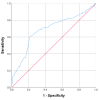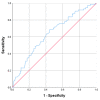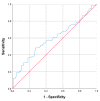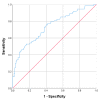Predicting Complicated Appendicitis in Children: Pros and Cons of a New Score Combining Clinical Signs, Laboratory Values, and Ultrasound Images (CLU Score)
- PMID: 37443669
- PMCID: PMC10340468
- DOI: 10.3390/diagnostics13132275
Predicting Complicated Appendicitis in Children: Pros and Cons of a New Score Combining Clinical Signs, Laboratory Values, and Ultrasound Images (CLU Score)
Abstract
Background: This retrospective study aimed to combine the clinical signs, laboratory values, and ultrasound images of 199 children with acute appendicitis in order to create a new predictive score for complicated appendicitis in children.
Methods: The study included children who had clinical examination of abdominal pain (description of pain, anorexia, body temperature, nausea or vomiting, duration of symptoms), laboratory findings on admission (white blood cell, platelets, neutrophils, C-reactive protein), preoperative abdominal ultrasound, and histopathological report after an operation for appendicitis in their records during the period from January 2016 to February 2022.
Results: According to the statistical analysis of the values using multivariate logistic regression models, the patients with appendiceal diameter ≥ 8.45 mm, no target sign appearance, appendicolith, abscess, peritonitis, neutrophils ≥ 78.95%, C-reactive protein ≥ 1.99 mg/dL, body temperature ≥ 38 °C, pain migration to right lower quadrant, and duration of symptoms < 24 h were more likely to suffer from complicated appendicitis. The new score was comprised of the 10 variables that were found statistically significant in the multivariate logistic model. Each of these variables was assigned a score of 1 due to the values that were associated with complicated appendicitis.
Conclusions: A cutoff value of ≥4 has been a good indicator of the final score. The sensitivity with the usage of this score is 81.1%, the specificity 82.4%, the PPV 73.2%, the NPV approaches 88% and finally the accuracy is 81.9%. Also, the pros and cons of this score are discussed in this study.
Keywords: complicated appendicitis; score; ultrasound; uncomplicated appendicitis.
Conflict of interest statement
The authors declare no conflict of interest.
Figures






Similar articles
-
The Prognostic Value of Ultrasound Findings in Preoperatively Distinguishing between Uncomplicated and Complicated Types of Pediatric Acute Appendicitis Based on Correlation with Intraoperative and Histopathological Findings.Diagnostics (Basel). 2022 Sep 26;12(10):2315. doi: 10.3390/diagnostics12102315. Diagnostics (Basel). 2022. PMID: 36292004 Free PMC article.
-
Scoring system to distinguish uncomplicated from complicated acute appendicitis.Br J Surg. 2015 Jul;102(8):979-90. doi: 10.1002/bjs.9835. Epub 2015 May 12. Br J Surg. 2015. PMID: 25963411
-
Combining Ultrasound with a Pediatric Appendicitis Score to Distinguish Complicated from Uncomplicated Appendicitis in a Pediatric Population.Acta Inform Med. 2020 Jun;28(2):114-118. doi: 10.5455/aim.2020.28.114-118. Acta Inform Med. 2020. PMID: 32742063 Free PMC article.
-
Factors affecting the length of hospital stay after laparoscopic appendectomy: A single center study.PLoS One. 2020 Dec 9;15(12):e0243575. doi: 10.1371/journal.pone.0243575. eCollection 2020. PLoS One. 2020. PMID: 33296384 Free PMC article.
-
Parsimonious clinical prediction model for the diagnosis of complicated appendicitis.Heliyon. 2023 Aug 14;9(8):e19067. doi: 10.1016/j.heliyon.2023.e19067. eCollection 2023 Aug. Heliyon. 2023. PMID: 37636395 Free PMC article.
Cited by
-
Complicated appendicitis and associated risk factors among children.BMC Pediatr. 2025 Apr 29;25(1):336. doi: 10.1186/s12887-025-05447-5. BMC Pediatr. 2025. PMID: 40301796 Free PMC article.
-
Trends in Simple and Complex Appendicitis in Children and the Potential Correlation to Common Viral Pathogens-A Retrospective Cohort Study between 2010 and 2019 in The Netherlands.Children (Basel). 2023 Dec 11;10(12):1912. doi: 10.3390/children10121912. Children (Basel). 2023. PMID: 38136114 Free PMC article.
-
Using shock index, pediatric age adjusted (SIPA) to predict prolonged length of stay in perforated appendicitis: a retrospective review.Pediatr Surg Int. 2024 Nov 5;40(1):290. doi: 10.1007/s00383-024-05873-z. Pediatr Surg Int. 2024. PMID: 39499304
References
-
- Benabbas R., Hanna M., Shah J., Sinert R. Diagnostic Accuracy of History, Physical Examination, Laboratory Tests, and Point-of-care Ultrasound for Pediatric Acute Appendicitis in the Emergency Department: A Systematic Review and Meta-analysis. Acad Emerg Med. 2017;24:523–551. doi: 10.1111/acem.13181. - DOI - PubMed
LinkOut - more resources
Full Text Sources
Research Materials
Miscellaneous

